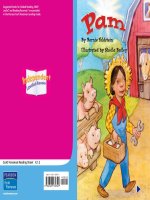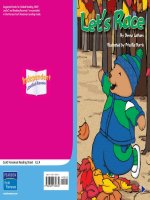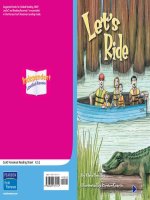- Trang chủ >>
- Mầm non - Tiểu học >>
- Lớp 5
5 1 4 african american athletes (social studies) TG
Bạn đang xem bản rút gọn của tài liệu. Xem và tải ngay bản đầy đủ của tài liệu tại đây (111.21 KB, 4 trang )
African American
Athletes
SUMMARY
This book traces the history of
African Americans in sports in the United
States. Before 1945, African Americans
were not allowed to play in most professional
sports. This book looks at individual athletes
who were able to break through the race barrier and set an example for others who follow.
Some of the athletes profiled include Satchel
Paige, Willie O’Ree, Jackie Robinson, Jesse
Owens, Hank Aaron, and Tiger Woods.
LESSON VOCABULARY
adversity
discrimination
integrated
prohibited
amateur
inferior
prejudiced
taunts
INTRODUCE THE BOOK
INTRODUCE THE TITLE AND AUTHOR
Discuss with
students the title and the author of African
American Athletes. Based on the title and the
cover photographs, ask students what they
imagine this book will be about.
BUILD BACKGROUND Have students name
some famous African American athletes. Ask
them if they knew there were times when
African Americans were not allowed to play
professional sports. Ask students what it
would be like to be prevented from doing what
they wanted to do because of the color of
their skin.
PREVIEW/USE TEXT FEATURES
Have students
look at the section headings and the
photographs and discuss how these text
elements help organize the book. Ask
students how the section headings may help
them understand what this book may be
about.
24
5.1.4
SEQUENCE
ASK QUESTIONS
READ THE BOOK
SET PURPOSE
Have students set a purpose for
reading African American Athletes. Students’
interest in sports can help guide this purpose.
As students read, suggest they take notes
that might provide answers to any questions
they could have about the subject.
STRATEGY SUPPORT: ASK QUESTIONS
Revisit how
asking questions before and during reading
can help keep the reader engaged with the
information in the text. Then discuss how
asking questions after reading can also help
them check comprehension and solidify what
they’ve learned. For example: What did I learn
about African American athletes that I didn’t
know before?
COMPREHENSION QUESTIONS
PAGE 4
Satchel Paige had names for some of
his pitches. Name a few. (bee ball, trouble ball,
Long Tom)
PAGE 6
Who was the first African American to
play professional basketball? (Earl Lloyd)
PAGE 7
Pro football was integrated from 1920
until 1933. What happened from 1934 to
1946? (African Americans were barred from
football.)
PAGE 8
What was unique about Willie O’Ree?
(He was the first African American to play ice
hockey, and he was blind in one eye.)
PAGE 12
How did Jackie Robinson respond to
threats and taunts after he started playing for
the Brooklyn Dodgers? (He didn’t get angry or
answer back.)
PAGE 19 Who has made more money playing
golf than anyone in history? (Tiger Woods)
African American Athletes
16924_LRD_TG_024-025 24
12/28/05 1:07:20 PM
REVISIT THE BOOK
READER RESPONSE
1. Football, 1946; baseball, 1947; basketball,
1950; hockey, 1958
2. Responses will vary.
3. Possible response: Professional hockey was
not integrated until the late 1950s.
4. Possible response: The photograph shows
that baseball had been integrated.
EXTEND UNDERSTANDING
Discuss with students
how sections in the book can help organize
complicated material. Go over the sections
with students and discuss what material is
in each and why. Ask students how they can
tell what each section is going to be about.
Guide them to see that the next section is a
progression.
RESPONSE OPTIONS
WRITING
Ask students to write a brief
paragraph expressing their feelings about
discrimination and prejudice.
SOCIAL STUDIES
CONNECTION
Have students take one
of the sports figures in
this book and do further
research on him or her. Students
can use the Internet and the library to find
information. How did the athlete deal with
discrimination that he or she may have faced
along the way?
Skill Work
TEACH/REVIEW VOCABULARY
To reinforce the contextual meaning of the
word discrimination on page 3, discuss
with students how the phrase “or unfair
treatment” suggests the meaning of
discrimination. Ask students to skim through
the text, locate other vocabulary words,
and identify the context clues that suggest
meaning.
Ask students to skim the story and
write down any unfamiliar words. Suggest
they look the words up in the dictionary and
write the meanings in their notebooks.
TARGET SKILL AND STRATEGY
SEQUENCE Remind students that the
sequence in a story or article is the order
in which the events occur. To better
understand what this means, ask students
to write a short paragraph about how
they clean their room or how they make
breakfast, keeping the actions in sequence.
Have students read their reports to the
class.
ASK QUESTIONS Remind students that
asking their own questions before, during,
and after they read will help them actively
engage with the material. It will also help
them reflect on what they read, identify the
author’s purpose, and separate statements
of fact from statements of opinion. Offer as
examples such questions as How did the
author organize the information? What is the
author trying to say here? Could I turn this
information into a story or movie?
ADDITIONAL SKILL INSTRUCTION
FACT AND OPINION Remind students that a
statement of fact is a statement that can
be proven true or false, and a statement of
opinion is someone’s judgment. A statement
of opinion cannot be proved true or false.
To give students practice, give them several
sentences, some of which are fact and
some opinion, and have students mark them
as such.
African American Athletes
16924_LRD_TG_024-025 25
25
1/11/06 3:12:54 PM
African American Athletes
Name
Sequence
• Understanding the sequence of events is important to having a correct understanding
of the text.
Directions Answer the following questions.
1. Besides Satchel Paige, who was another great African American baseball player who
preceded Jackie Robinson? What position did he play?
2. African Americans were not allowed to play basketball until 1950. Who was the first player
to break the race barrier?
3. Hockey was one of the last of the major sports to be integrated. In what year did Willie O’Ree
start playing professional hockey?
4. Which baseball player broke through racial barriers and became the first African American
to play for a major baseball team? How long would it take for most teams to have African
Americans playing for them?
5. What happened to Jesse Owens after winning four gold medals at the 1936 Olympics in Berlin?
Did he have a successful career as an athlete?
1950
Jackie Robinson, baseball
1958
Jesse Owens, track and field
1947
Earl Lloyd, basketball
1948
Willie O’Ree, hockey
1936
Satchel Paige, baseball
© Pearson Education 5
Directions Match each year to the man who started playing his sport then.
26
16924_LRD_TG_026-027 26
12/28/05 1:07:53 PM
African American Athletes
Name
Vocabulary
Directions Draw a line from each word to its definition.
Check the Words You Know
adversity
discrimination
integrated
prohibited
amateur
inferior
prejudiced
taunts
1. adversity
jeers; mocking or insulting remarks
2. amateur
below most others; low in quality
3. taunts
condition of misfortune or distress
4. discrimination
forbidden by law from doing something
5. inferior
when a public place or group has been opened to all races.
6. integrated
someone who plays something for pleasure, instead of for money
or as a profession.
7. prejudiced
having an unreasonable dislike for someone or something
8. prohibited
act of showing an unfair difference in treatment
Directions Select four vocabulary words and use each in a sentence.
9.
© Pearson Education 5
10.
11.
12.
27
16924_LRD_TG_026-027 27
12/28/05 1:07:54 PM









